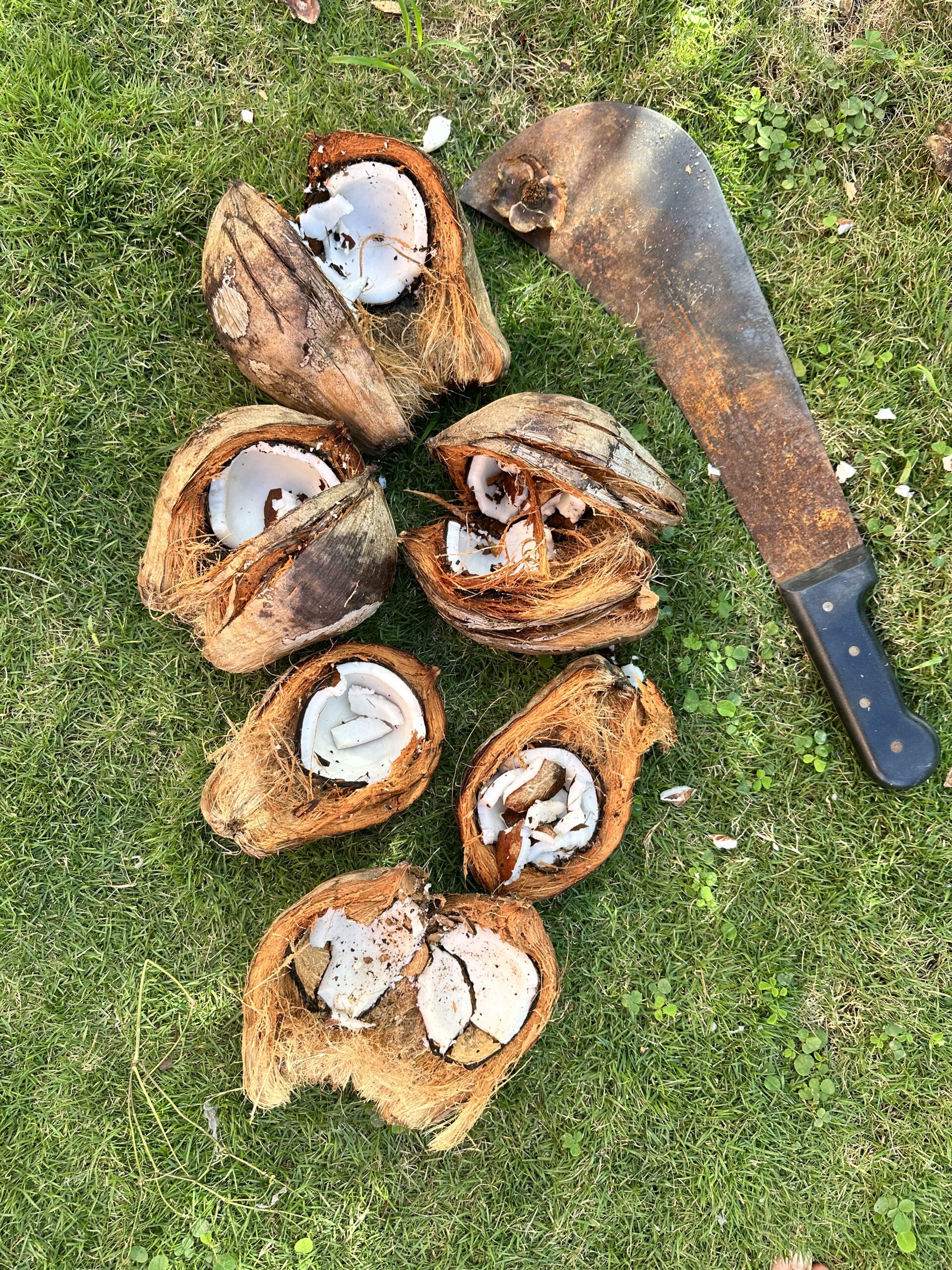
DIY Coconut Milk
DIY: Homemade Coconut Milk
If you have visited us in Puerto Rico, chances are you have either had a meal made with fresh DIY coconut milk or sipped our cocos right from the tree for their sweet young water. We have been told we have the best coconuts around!
Frequently we are asked “What’s the difference between coconut milk and coconut water?” So here’s the low down:
Green coconuts, are the youthful gems of the coconut palm, offering a versatile spectrum of flavors. Initially filled with a sweet, hydrating water, these coconuts mature to contain tender, young meat known as jelly. This jelly is a delicacy cherished for its luscious texture and flavor. It makes the most delectable late morning or afternoon snack especially while sipping coconut water.
Some think that eventually this water naturally turns into coconut milk, however, it actually matures beyond jelly into the coconut meat which we harvest and process into the most creamy milk available.
Step 1: Picking Your Coconut
In our quest for the perfect coconut milk, we prioritize mature coconuts. Specifically those with a brown husk will ideally harbor the thickest meat inside. However, sometimes all we have are younger coconuts. As these younger coconuts mature, their jelly hardens, transforming them into excellent candidates for producing rich and thick coconut milk.
Timing is everything. If the coconuts are too green, their meat may not have developed the mature oils essential for that luxurious coconut milk. If it’s too mature, the meat will appear dry and grey. We recommend if you do crack open a green coconut brimming with jelly just do yourself a favor and eat it!
Step 2: Get the Coconut Meat
Now we can dive into the heart of the coconut. Grab your machete and get cracking! Once the coconut is open, consider saving the water if possible. As you see in the photos you can carefully scrape or pop the meat out with the back side of a knife or spoon. However, for an even smoother experience consider investing in a Stainless Steel Coconut Meat Remover. This tool was a game-changer in our household.
After you remove all the meat from the coconut, rinse it with clean water to wash away any debris and check for any hard shell fragments that could be lingering. This saves the blender blades from excess wear and sets you up for the purest, most flavorful DIY coconut milk.
Step 3: Time to Blend the Coconut Milk
Place meat in a high-powered blender. We swear by our Vitamix for its unparalleled efficiency in handling tougher ingredients. If your blender has issues with harder substances, a Coconut Scraper followed by a gentle blend will do the trick.
For the blending process, add the chunks of coconut meat to the blender and cover with water, aiming for about an inch above the meat. It’s important to note that the water quantity directly influences the milk’s consistency—more water results in thinner milk, so adjust according to your culinary needs.
Initiate blending on a low setting, gradually increasing speed and power. In the Vitamix the coconut is transformed into a fine meal, ensuring maximum extraction of the coconut’s rich fats. This blending process is the secret to achieving the most flavorful and creamy DIY coconut milk.
Step 4: Strain the Coconut Milk
The straining phase is crucial in the DIY coconut milk-making process, marking the difference between good and exceptional milk. While you can use a thin strainer and simply pour the milk through into a bowl we recommend using a cotton cloth to really get every last drop out of the milk. Sometimes cheese cloth or nut milk straining sacks can be too thin and easily break or parts of the coconut push through. For this reason we like to use an old clean cotton shirt or reusable cotton flour sacks. This allows you to really twist and strain without any mishaps.
After you have extracted the coconut milk store in a clean glass jar for up to 4 days.
Using Fresh Coconut Milk
We use fresh coconut milk all the time from chai lattes to curries to breakfast dishes. You can find it in our fragrant Lemongrass Coconut Rice, nutritious Coco-Apple Oats, and hearty Pumpkin Sweet Potato Soup just to name a few recipes!
What Ayurveda Says About Coconut Milk
Young coconut jelly has a higher water content and will be easier to digest because its softer. As the coconut matures, its meat becomes denser, firmer, and more challenging to chew, often leading to a naturally reduced consumption due to its texture. These effects are the same on the digestive system. If your digestive fire is strong coconut meat is a great nutrient dense snack or additive to meals. Sometimes we grate mature meat and use it for cooking or toasting it for a nutty sweet topping to breakfast porridge, rice or even vegetables like our Green Beans with Curry Leaf or the Green Mango Chutney Recipes.
While coconuts are oily and heavy to digest they are a versatile food that can build tissue, nourish the body, and have a cooling energy to them.
The best way to enjoy coconut depends on your dosha, ensuring that it aligns with your body’s needs for optimal health and balance. Here’s how to incorporate coconut into your diet according to your Ayurvedic constitution:
- Vata: the lightness of coconut water, the soothing warmth of spiced coconut milk, or the softness of coconut jelly are ideal. These forms are easier to digest compared to the denser, mature coconut meat.
- Pitta: coconut water and coconut jelly offer more hydration and less oil than more mature meat. Toasted coconut, added to meals or transformed into coconut milk, can be suitable in moderation. However, those with highly sensitive digestion might find younger coconut meat easier on the digestive system due to its lower oil content.
- Kapha: coconut water or very young coconut jelly would be ideal in moderation especially if its not to sweet. This recommendation is due to their lighter nature, which are less heavy and oily than mature coconut meat or coconut milk.
Coconut Water in the Ancient Texts
If you study the main texts of Ayurveda (Bruhana or Big Texts) they even list the benefits of consuming coconut water. It’s interesting as a source of hydration, especially in the wild because it does not need filtering as it’s done within the coconut itself. This makes it an easy choice! In the text they offer the following description for coconut water.
- Demulcent
- Tasty- improves taste of food if drinking fresh coconut water
- Cooling- reduces pitta dosha and excess heat in the body
- Pleasant for mind- makes you happy
- Aphrodisiac- improves reproductive tissues (good for fertility issues)
- Pitta pacifying- sweet in taste and cooling virya so pitta pacifying in nature
- Relieves thirst- electrolyte balanced
- Cleanses urinary system- kidney, bladder, urinary infection can be cleansed but if someone has a kidney disease and need to reduce water intake coconut water would be included but otherwise it can help clean the urinary tract
It’s important to note this this only applies to fresh coconut water. Store bought coconut water drinks do not have the same effect and are not recommended. You would be better served to make the Ayurveda-Aide for hydration or plan a trip to the tropics and we can sip coconuts together!
Want to learn more about building an Ayurvedic Meal Plan just for you?
We offer individualized health consultations where your unique dietary needs and digestive health are our top priority. We specialize in crafting individualized dietary plans and providing personalized care that aligns with your specific health goals. Whether you’re seeking to optimize your digestion, adjust your eating habits, or require comprehensive health guidance, we’re here to support you every step of the way. Don’t wait to transform your health – sign up for your first session today!









